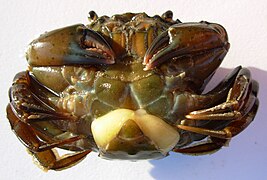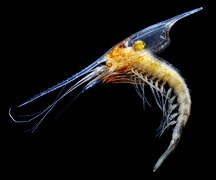Multicrustacea
| Multicrustacea Temporal range:
| |
|---|---|

| |
| From left to right and from top to bottom: Euphausia superba (a krill), Hemilepistus reaumuri (a woodlouse), Calanoida (a copepod), and Lepas anatifera (a barnacle)
| |
| Scientific classification | |
| Domain: | Eukaryota |
| Kingdom: | Animalia |
| Phylum: | Arthropoda |
| Clade: | Pancrustacea |
| Superclass: | Multicrustacea Regier, Shultz, Zwick, Hussey, Ball, Wetzer, Martin & Cunningham, 2010 |
| Classes | |
| |
The
woodlice, barnacles, copepods, amphipods, mantis shrimp and others. The largest branch of multicrustacea is the class Malacostraca
(see below).
Classification
Superclass Multicrustacea Regier, Shultz, Zwick, Hussey, Ball, Wetzer, Martin & Cunningham, 2010 [5]
- †Family Priscansermarinidae Newman, 2004
- Class Copepoda Milne-Edwards, 1840 - Copepods [a]
- Infra-class NeocopepodaHuys & Boxshall, 1991
- Super-order GymnopleaGiesbrecht, 1882
- Order Calanoida Sars GO, 1903
- Super-order Podoplea Giesbrecht, 1882
- Order Cyclopoida Burmeister, 1834
- Order GelyelloidaHuys, 1988
- Order Harpacticoida G. O. Sars, 1903
- Order Misophrioida Gurney, 1933
- Order Monstrilloida Sars, 1901
- Order MormonilloidaBoxshall,1979
- Order CanuelloidaKhodami, Vaun MacArthur, Blanco-Bercial & Martinez Arbizu, 2017 )
- Order Siphonostomatoida Thorell, 1859
- Super-order
- Infra-class ProgymnopleaLang, 1948
- Order PlatycopioidaFosshagen, 1985
- Order
- Infra-class
- Class Thecostraca Gruvel, 1905[7][a]
- Subclass Ascothoracida Lacaze-Duthiers, 1880
- Order Dendrogastrida Grygier, 1987
- Order Laurida Grygier, 1987
- Subclass CirripediaBurmeister, 1834
- Infraclass Acrothoracica Gruvel, 1905
- Order CryptophialidaKolbasov, Newman & Hoeg, 2009
- Order Lithoglyptida Kolbasov, Newman & Hoeg, 2009
- Order
- Infraclass Rhizocephala Müller, 1862
- Infraclass Thoracica Darwin, 1854
- Superorder Phosphatothoracica Gale, 2019
- Order Iblomorpha Buckeridge & Newman, 2006
- †Order Eolepadomorpha Chan et al., 2021
- Superorder Thoracicalcarea Gale, 2015
- Order Balanomorpha Pilsbry, 1916
- Order Calanticomorpha Chan et al., 2021
- Order Pollicipedomorpha Chan et al., 2021
- Order Scalpellomorpha Buckeridge & Newman, 2006
- Order Verrucomorpha Pilsbry, 1916
- †Order Archaeolepadomorpha Chan et al., 2021
- †Order BrachylepadomorphaWithers, 1923
- Superorder Phosphatothoracica Gale, 2019
- Infraclass Acrothoracica Gruvel, 1905
- Subclass Facetotecta Grygier, 1985
- Subclass Ascothoracida Lacaze-Duthiers, 1880
- Class Tantulocarida Boxshall & Lincoln, 1983
- Family Basipodellidae Boxshall & Lincoln, 1983
- Family DeoterthridaeBoxshall & Lincoln, 1987)
- Family Doryphallophoridae Huys, 1991
- Family Microdajidae Boxshall & Lincoln, 1987
- Family OnceroxenidaeHuys, 1991
- Class Malacostraca Latreille, 1802
- Subclass Eumalacostraca Grobben, 1892
- Superorder Eucarida Calman, 1904
- Order AmphionidaceaWilliamson, 1973)
- Order Euphausiacea Dana, 1852 - krill
- Order
- Superorder Peracarida Calman, 1904
- Order Amphipoda Latreille, 1816 - amphipodes, gammares
- Order BochusaceaGutu & Iliffe, 1998
- Order Cumacea Krøyer, 1846 - cumaceae
- Order Ingolfiellida Hansen, 1903
- Order Isopoda Latreille, 1817 - isopods (including clover)
- Order Lophogastrida Sars, 1870 - lophogastrides
- Order Mictacea Bowman, Garner, Hessler, Iliffe & Sanders, 1985 - mictacés
- Order Mysida Haworth, 1825 - mysidacés
- †Order Pygocephalomorpha
- Order Spelaeogriphacea Gordon, 1957 - spelaeogriphaceae
- Order Stygiomysida Tchindonova, 1981 - stygiomysides
- Order Tanaidacea Dana, 1849 - tanaidaceae
- Order Thermosbaenacea Monod, 1927 - thermosbaenaceae
- Superorder Syncarida Packard, 1879
- Order Anaspidacea Calman, 1904
- Order Bathynellacea Chappuis, 1915
- †Order Palaeocaridacea Brooks, 1962
- Superorder Eucarida Calman, 1904
- Subclass Hoplocarida Calman, 1904
- Order StomatopodaLatreille, 1817 - shrimps-mantes
- Order
- Subclass Phyllocarida Packard, 1879
- †Order Archaeostraca Claus, 1888
- †Order CanadaspididaNovozhilov, 1960
- †Order Hoplostraca Schram, 1973
- †Order HymenostracaRolfe, 1969
- Order Leptostraca Claus, 1880
- †Genus Nothozoe Barrande, 1872
- Subclass Eumalacostraca Grobben, 1892
- Incertae sedis
- Order Cyclida
Notes:
- ^ a b Class Hexanauplia Oakley, Wolfe, Lindgren & Zaharof, 2013 was proposed for copepods and thecopods, but not supported by subsequent studies.[6]
Fossil record
This section needs expansion. You can help by adding to it. (December 2023) |
The earliest fossils representative of Multicrustacea are from the Cambrian.[8] However, the more specific timeline is uncertain. Some Cambrian fossils of uncertain taxonomic placement, such as those of Priscansermarinus, are nonetheless likely to be members of Multicrustacea.[citation needed]
Image gallery
-
Sacculina Sacculina carcini (Rhizocephala) parasite of a crab.
-
Anew Lepas anatifera (Lepadiformes)
-
Balth Chthamalus stellatus (Sessilia)
-
Inch-footScalpelliformes)
-
Amphionidaceaknown.
-
Crab Cancer bellianus (Eucarida)
-
Antarctic KrillEuphausiacea)
-
Mictocaris halope (Mictacea)
-
Stomatopoda)
Taxonomic references
- World Register of Marine Species : taxon Multicrustacea Regier Shultz Zwick Hussey, Ball, Wetzer, Martin & Cunningham, 2010 ( + class list + orders list)
- Tree of Life Web Project : Multicrustacea
- Animal Diversity Web : Multicrustacea[permanent dead link]
- Catalog of Life : Multicrustacea
- IUCN : taxon Multicrustacea
Notes and references
- PMID 15734694.
- S2CID 4427443.
- PMID 22049065.
- PMID 22977117.
- ^ WoRMS. "Multicrustacea". World Register of Marine Species. Retrieved 14 December 2022.
- ^ WoRMS. "Hexanauplia". World Register of Marine Species. Retrieved 14 December 2022.
- ^ "World Register of Marine Species, Class Thecostraca". Retrieved 2021-08-24.
- S2CID 85074218.


















